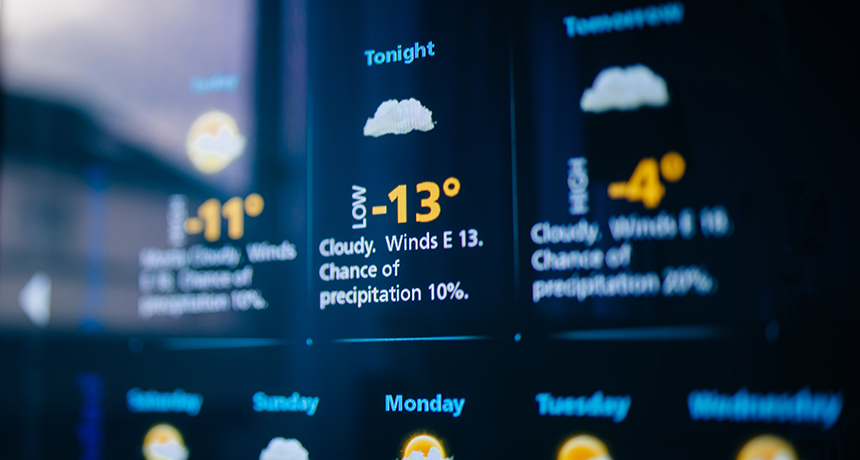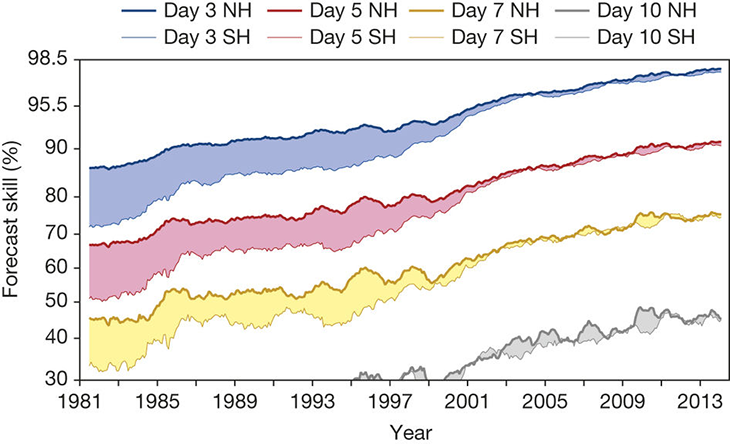Explainer: Weather and weather prediction
It only seems like the weather forecaster on TV is doing a bad job

Weather forecasts are now easily available. Although they have a reputation for not being all that accurate, that actually is not so true.
AdrianHancu/iStockphoto
Weather is one of those things that you don’t really notice until it somehow affects your life directly, usually in a bad way. A thunderstorm rains out the baseball game. A hurricane floods a town. A blizzard closes school. OK, it’s not always bad.
Kevin Petty is a meteorologist and chief scientific officer for Vaisala, in Louisville, Colo. The company provides weather-related observations and software to governments and other groups to help guide their decision-making. He describes weather as the atmospheric conditions that occur in a place over a relatively short period of time. It’s the rain that comes through on a summer day. Or the cold that makes you wear a coat in winter.
But where does weather come from? The sun provides energy that drives the weather. Other features also play a role. These include Earth’s oceans, its land cover, the chemistry of its atmosphere and the planet’s rotation. If any of those were different, we would experience very different weather patterns. And if the planet was just a bare rock orbiting a star, there would be no weather at all.
Not so long ago in human history, weather was just something that happened. People would know generally what to expect from season to season. A region’s climate — the long-term average of weather — didn’t tend to vary much from year to year. People might know to expect snow in winter, for instance, and hot weather in summer. But they wouldn’t know if it would snow on any particular day or whether some July drought would develop, putting fields of wheat at risk.
Today, you need only turn on the TV or pull out your phone to have a prediction for what the upcoming weather will be. “People always say the weather guy is wrong,” notes Petty, “which is not really true.” Some of that is psychological. “We never fault the weather guy when it’s … beautiful outside,” he says. “We only notice when the forecast goes wrong.”
And yes, sometimes the weather forecaster gets it wrong. Scientists have understood the basic physics behind the weather for more than a century. But they required computer models and reliable weather data to turn that knowledge into reliable forecasts. Today, computers take that knowledge of what Earth is like and use it to predict the weather. And that’s one of the reasons why forecasts aren’t always right — there just aren’t enough data for those computer models to work with.
Areas like the United States are generally well-covered with weather stations and with meteorologists who send weather balloons into the atmosphere to collect data. But there are a lot fewer of these over the oceans and in less populated places, such as deserts, as well as poorer countries.
As more reliable data have become available, computing resources have gotten better, computer models have improved and weather predictions have improved. “If you look over the last four to five decades, our ability to forecast the weather has improved dramatically,” Petty says. Three-day forecasts are around 98 percent accurate worldwide. That’s according to a 2016 review in Nature. In 1981, they had been less than 90 percent accurate in the Northern Hemisphere and less than 80 percent accurate in the South. Ten-day forecasts weren’t even introduced until the mid-1990s. They are now around 40 percent accurate.
Story continues below image.

Good forecasts have proven even more important in preparing for extreme weather. Meteorologists can now forecast the intensity of a hurricane — and its potential track — days in advance. And people in the path of tornadoes now can get far more warning of potential danger than they did just 20 years ago.
Scientists are working to improve forecasts even more. Because of the complexity of Earth’s system, computer models still can’t simulate everything going on with the planet. And that limits the accuracy of forecasts, Petty notes. There also still is a need for better observations in parts of the world where weather stations are few and far between.
But weather forecasts, imperfect as they sometimes seem, already are a key piece of knowledge in today’s world. They let cities, counties and states plan where and when to position snowplows before a snowstorm. Electric companies know which days their wind farms will produce the most energy. Forecasts help airlines route planes around hurricanes and thunderstorms and decide when their planes will need de-icer applied to their wings. And of course, they let kids plan ahead for snow days!







